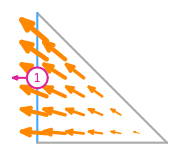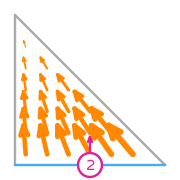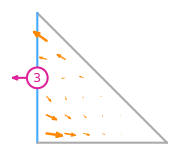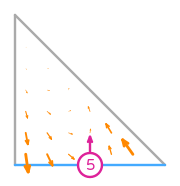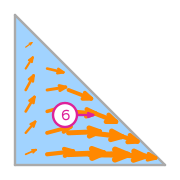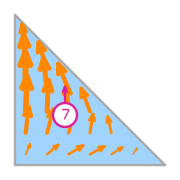an encyclopedia of finite element definitions
Degree 1 Raviart–Thomas on a triangle
◀ Back to Raviart–Thomas definition page
- \(R\) is the reference triangle. The following numbering of the sub-entities of the reference cell is used:
- \(\mathcal{V}\) is spanned by: \(\left(\begin{array}{c}\displaystyle 1\\\displaystyle 0\end{array}\right)\), \(\left(\begin{array}{c}\displaystyle 0\\\displaystyle 1\end{array}\right)\), \(\left(\begin{array}{c}\displaystyle x\\\displaystyle 0\end{array}\right)\), \(\left(\begin{array}{c}\displaystyle 0\\\displaystyle x\end{array}\right)\), \(\left(\begin{array}{c}\displaystyle y\\\displaystyle 0\end{array}\right)\), \(\left(\begin{array}{c}\displaystyle 0\\\displaystyle y\end{array}\right)\), \(\left(\begin{array}{c}\displaystyle x^{2}\\\displaystyle x y\end{array}\right)\), \(\left(\begin{array}{c}\displaystyle x y\\\displaystyle y^{2}\end{array}\right)\)
- \(\mathcal{L}=\{l_0,...,l_{7}\}\)
- Functionals and basis functions:

\(\displaystyle l_{0}:\boldsymbol{v}\mapsto\displaystyle\int_{e_{0}}\boldsymbol{v}\cdot(1)\hat{\boldsymbol{n}}_{0}\)
where \(e_{0}\) is the 0th edge;
and \(\hat{\boldsymbol{n}}_{0}\) is the normal to facet 0.
\(\displaystyle \boldsymbol{\phi}_{0} = \left(\begin{array}{c}\displaystyle x \left(4 y - 1\right)\\\displaystyle 4 y^{2} - 5 y + 1\end{array}\right)\)
This DOF is associated with edge 0 of the reference cell.
where \(e_{0}\) is the 0th edge;
and \(\hat{\boldsymbol{n}}_{0}\) is the normal to facet 0.
\(\displaystyle \boldsymbol{\phi}_{0} = \left(\begin{array}{c}\displaystyle x \left(4 y - 1\right)\\\displaystyle 4 y^{2} - 5 y + 1\end{array}\right)\)
This DOF is associated with edge 0 of the reference cell.
\(\displaystyle l_{1}:\boldsymbol{v}\mapsto\displaystyle\int_{e_{0}}\boldsymbol{v}\cdot(\sqrt{3} \left(2 s_{0} - 1\right))\hat{\boldsymbol{n}}_{0}\)
where \(e_{0}\) is the 0th edge;
\(\hat{\boldsymbol{n}}_{0}\) is the normal to facet 0;
and \(s_{0},s_{1}\) is a parametrisation of \(e_{0}\).
\(\displaystyle \boldsymbol{\phi}_{1} = \left(\begin{array}{c}\displaystyle \frac{\sqrt{3} x \left(- 8 x - 4 y + 5\right)}{3}\\\displaystyle \frac{\sqrt{3} \left(- 8 x y + 6 x - 4 y^{2} + 7 y - 3\right)}{3}\end{array}\right)\)
This DOF is associated with edge 0 of the reference cell.
where \(e_{0}\) is the 0th edge;
\(\hat{\boldsymbol{n}}_{0}\) is the normal to facet 0;
and \(s_{0},s_{1}\) is a parametrisation of \(e_{0}\).
\(\displaystyle \boldsymbol{\phi}_{1} = \left(\begin{array}{c}\displaystyle \frac{\sqrt{3} x \left(- 8 x - 4 y + 5\right)}{3}\\\displaystyle \frac{\sqrt{3} \left(- 8 x y + 6 x - 4 y^{2} + 7 y - 3\right)}{3}\end{array}\right)\)
This DOF is associated with edge 0 of the reference cell.
\(\displaystyle l_{2}:\boldsymbol{v}\mapsto\displaystyle\int_{e_{1}}\boldsymbol{v}\cdot(1)\hat{\boldsymbol{n}}_{1}\)
where \(e_{1}\) is the 1st edge;
and \(\hat{\boldsymbol{n}}_{1}\) is the normal to facet 1.
\(\displaystyle \boldsymbol{\phi}_{2} = \left(\begin{array}{c}\displaystyle - 4 x^{2} + 5 x - 1\\\displaystyle y \left(1 - 4 x\right)\end{array}\right)\)
This DOF is associated with edge 1 of the reference cell.
where \(e_{1}\) is the 1st edge;
and \(\hat{\boldsymbol{n}}_{1}\) is the normal to facet 1.
\(\displaystyle \boldsymbol{\phi}_{2} = \left(\begin{array}{c}\displaystyle - 4 x^{2} + 5 x - 1\\\displaystyle y \left(1 - 4 x\right)\end{array}\right)\)
This DOF is associated with edge 1 of the reference cell.
\(\displaystyle l_{3}:\boldsymbol{v}\mapsto\displaystyle\int_{e_{1}}\boldsymbol{v}\cdot(\sqrt{3} \left(2 s_{0} - 1\right))\hat{\boldsymbol{n}}_{1}\)
where \(e_{1}\) is the 1st edge;
\(\hat{\boldsymbol{n}}_{1}\) is the normal to facet 1;
and \(s_{0},s_{1}\) is a parametrisation of \(e_{1}\).
\(\displaystyle \boldsymbol{\phi}_{3} = \left(\begin{array}{c}\displaystyle \frac{\sqrt{3} \left(4 x^{2} + 8 x y - 7 x - 6 y + 3\right)}{3}\\\displaystyle \frac{\sqrt{3} y \left(4 x + 8 y - 5\right)}{3}\end{array}\right)\)
This DOF is associated with edge 1 of the reference cell.
where \(e_{1}\) is the 1st edge;
\(\hat{\boldsymbol{n}}_{1}\) is the normal to facet 1;
and \(s_{0},s_{1}\) is a parametrisation of \(e_{1}\).
\(\displaystyle \boldsymbol{\phi}_{3} = \left(\begin{array}{c}\displaystyle \frac{\sqrt{3} \left(4 x^{2} + 8 x y - 7 x - 6 y + 3\right)}{3}\\\displaystyle \frac{\sqrt{3} y \left(4 x + 8 y - 5\right)}{3}\end{array}\right)\)
This DOF is associated with edge 1 of the reference cell.
\(\displaystyle l_{4}:\boldsymbol{v}\mapsto\displaystyle\int_{e_{2}}\boldsymbol{v}\cdot(1)\hat{\boldsymbol{n}}_{2}\)
where \(e_{2}\) is the 2nd edge;
and \(\hat{\boldsymbol{n}}_{2}\) is the normal to facet 2.
\(\displaystyle \boldsymbol{\phi}_{4} = \left(\begin{array}{c}\displaystyle x \left(- 4 x - 4 y + 3\right)\\\displaystyle y \left(- 4 x - 4 y + 3\right)\end{array}\right)\)
This DOF is associated with edge 2 of the reference cell.
where \(e_{2}\) is the 2nd edge;
and \(\hat{\boldsymbol{n}}_{2}\) is the normal to facet 2.
\(\displaystyle \boldsymbol{\phi}_{4} = \left(\begin{array}{c}\displaystyle x \left(- 4 x - 4 y + 3\right)\\\displaystyle y \left(- 4 x - 4 y + 3\right)\end{array}\right)\)
This DOF is associated with edge 2 of the reference cell.
\(\displaystyle l_{5}:\boldsymbol{v}\mapsto\displaystyle\int_{e_{2}}\boldsymbol{v}\cdot(\sqrt{3} \left(2 s_{0} - 1\right))\hat{\boldsymbol{n}}_{2}\)
where \(e_{2}\) is the 2nd edge;
\(\hat{\boldsymbol{n}}_{2}\) is the normal to facet 2;
and \(s_{0},s_{1}\) is a parametrisation of \(e_{2}\).
\(\displaystyle \boldsymbol{\phi}_{5} = \left(\begin{array}{c}\displaystyle \frac{\sqrt{3} x \left(4 x - 4 y - 1\right)}{3}\\\displaystyle \frac{\sqrt{3} y \left(4 x - 4 y + 1\right)}{3}\end{array}\right)\)
This DOF is associated with edge 2 of the reference cell.
where \(e_{2}\) is the 2nd edge;
\(\hat{\boldsymbol{n}}_{2}\) is the normal to facet 2;
and \(s_{0},s_{1}\) is a parametrisation of \(e_{2}\).
\(\displaystyle \boldsymbol{\phi}_{5} = \left(\begin{array}{c}\displaystyle \frac{\sqrt{3} x \left(4 x - 4 y - 1\right)}{3}\\\displaystyle \frac{\sqrt{3} y \left(4 x - 4 y + 1\right)}{3}\end{array}\right)\)
This DOF is associated with edge 2 of the reference cell.
\(\displaystyle l_{6}:\boldsymbol{v}\mapsto\displaystyle\int_{R}\boldsymbol{v}\cdot\left(\begin{array}{c}\sqrt{2}\\0\end{array}\right)\)
where \(R\) is the reference element.
\(\displaystyle \boldsymbol{\phi}_{6} = \left(\begin{array}{c}\displaystyle 4 \sqrt{2} x \left(- 2 x - y + 2\right)\\\displaystyle 4 \sqrt{2} y \left(- 2 x - y + 1\right)\end{array}\right)\)
This DOF is associated with face 0 of the reference cell.
where \(R\) is the reference element.
\(\displaystyle \boldsymbol{\phi}_{6} = \left(\begin{array}{c}\displaystyle 4 \sqrt{2} x \left(- 2 x - y + 2\right)\\\displaystyle 4 \sqrt{2} y \left(- 2 x - y + 1\right)\end{array}\right)\)
This DOF is associated with face 0 of the reference cell.
\(\displaystyle l_{7}:\boldsymbol{v}\mapsto\displaystyle\int_{R}\boldsymbol{v}\cdot\left(\begin{array}{c}0\\\sqrt{2}\end{array}\right)\)
where \(R\) is the reference element.
\(\displaystyle \boldsymbol{\phi}_{7} = \left(\begin{array}{c}\displaystyle 4 \sqrt{2} x \left(- x - 2 y + 1\right)\\\displaystyle 4 \sqrt{2} y \left(- x - 2 y + 2\right)\end{array}\right)\)
This DOF is associated with face 0 of the reference cell.
where \(R\) is the reference element.
\(\displaystyle \boldsymbol{\phi}_{7} = \left(\begin{array}{c}\displaystyle 4 \sqrt{2} x \left(- x - 2 y + 1\right)\\\displaystyle 4 \sqrt{2} y \left(- x - 2 y + 2\right)\end{array}\right)\)
This DOF is associated with face 0 of the reference cell.

